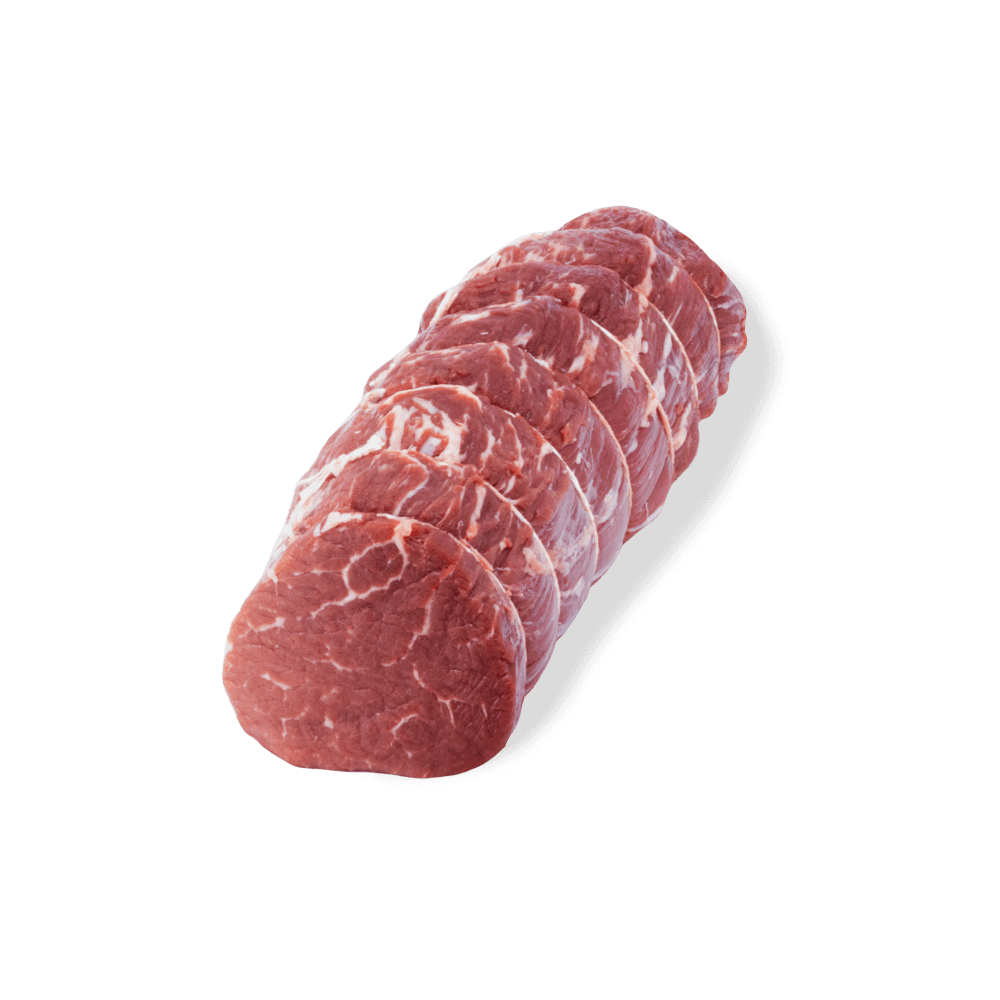 USDA Choice: Adding a USDA Choice roast to our lineup is new for us this year, and a result of the astronomically high pricing that the Prime market is facing. While we are comfortable offering a Choice tenderloin roast, this is the only one of our top selling cuts that we feel we can drop the grade and still guarantee a phenomenal experience. Being the single most tender cut from the beef, there will not be a night and day tenderness difference between a Prime Tenderloin Roast and a Choice Tenderloin Roast, like there would be if dropping to a Choice Rib or Club Roast.
USDA Choice: Adding a USDA Choice roast to our lineup is new for us this year, and a result of the astronomically high pricing that the Prime market is facing. While we are comfortable offering a Choice tenderloin roast, this is the only one of our top selling cuts that we feel we can drop the grade and still guarantee a phenomenal experience. Being the single most tender cut from the beef, there will not be a night and day tenderness difference between a Prime Tenderloin Roast and a Choice Tenderloin Roast, like there would be if dropping to a Choice Rib or Club Roast.
 ANGUS CATTLE: these tenderloins come from Angus Cattle, raised in the Midwest.
ANGUS CATTLE: these tenderloins come from Angus Cattle, raised in the Midwest.
 SHIP FRESH: We cut these roasts fresh the day we ship out, and once they are received they are good for 5-6days in your refrigerator, or 6-7months in the freezer.
SHIP FRESH: We cut these roasts fresh the day we ship out, and once they are received they are good for 5-6days in your refrigerator, or 6-7months in the freezer.
 UN-AGED: Because the tenderloin muscle has very little protective covering (such as fat or bone), we do not dry age this cut.
UN-AGED: Because the tenderloin muscle has very little protective covering (such as fat or bone), we do not dry age this cut.
Inflation has hit our supply chain, and the cost of the Prime grade filets has created this opportunity. In ten words or less, the filet is strong on tenderness, but weak on flavor. The tenderness will be similar between the two grades of this particular cut, and the minimal flavor swing makes it hard to justify the cost of the Prime grade presently. We are unequivocally confident that the Choice grade tenderloins we have sourced will meet and possibly exceed your expectations- at a better price point than the Prime grade.
The Filet Roast is a classic example of a delicate yet elegant roasting option. This roast is made from the Tenderloin which is unquestionably the most tender cut of all. In the cutting process, slightly over 50% of the starting piece is removed leaving a uniform shaped center cut “barrel” that is almost completely void of fat; so when absolutely lean is preferred, this will fit the bill. We then tie with butcher’s twine more for assuring uniform thickness than anything else as when trimmed to this point, it is a solid single piece. The benefit of uniformity will be in a consistent and even cooking time and as important at the Holidays, a uniform slicing and plating experience.
While clearly the most tender of all the roasts, the “good news/bad news” here is that it is not the most flavorful. However, rather than a problem, it is an opportunity to be creative in the flavoring department. I am always more liberal with seasonings when cooking a Filet Roast- things I would never use on a Rib Roast are doable with a Filet Roast. Not only that, but the entire range of sauces* can be complimentary so you can choose your favorite and end up with a successful entrée.
In terms of ordering quantity, the Filet Roast is the easiest to figure. I use a formula of 8 to 10 ounces per needed portions; The roast will hardly shrink during the cooking, and since there is zero waste, you can be much more exact in ordering size.
![]() USDA Choice: Adding a USDA Choice roast to our lineup is new for us this year, and a result of the astronomically high pricing that the Prime market is facing. While we are comfortable offering a Choice tenderloin roast, this is the only one of our top selling cuts that we feel we can drop the grade and still guarantee a phenomenal experience. Being the single most tender cut from the beef, there will not be a night and day tenderness difference between a Prime Tenderloin Roast and a Choice Tenderloin Roast, like there would be if dropping to a Choice Rib or Club Roast.
USDA Choice: Adding a USDA Choice roast to our lineup is new for us this year, and a result of the astronomically high pricing that the Prime market is facing. While we are comfortable offering a Choice tenderloin roast, this is the only one of our top selling cuts that we feel we can drop the grade and still guarantee a phenomenal experience. Being the single most tender cut from the beef, there will not be a night and day tenderness difference between a Prime Tenderloin Roast and a Choice Tenderloin Roast, like there would be if dropping to a Choice Rib or Club Roast.![]() ANGUS CATTLE: these tenderloins come from Angus Cattle, raised in the Midwest.
ANGUS CATTLE: these tenderloins come from Angus Cattle, raised in the Midwest.![]() SHIP FRESH: We cut these roasts fresh the day we ship out, and once they are received they are good for 5-6days in your refrigerator, or 6-7months in the freezer.
SHIP FRESH: We cut these roasts fresh the day we ship out, and once they are received they are good for 5-6days in your refrigerator, or 6-7months in the freezer.![]() UN-AGED: Because the tenderloin muscle has very little protective covering (such as fat or bone), we do not dry age this cut.
UN-AGED: Because the tenderloin muscle has very little protective covering (such as fat or bone), we do not dry age this cut.
